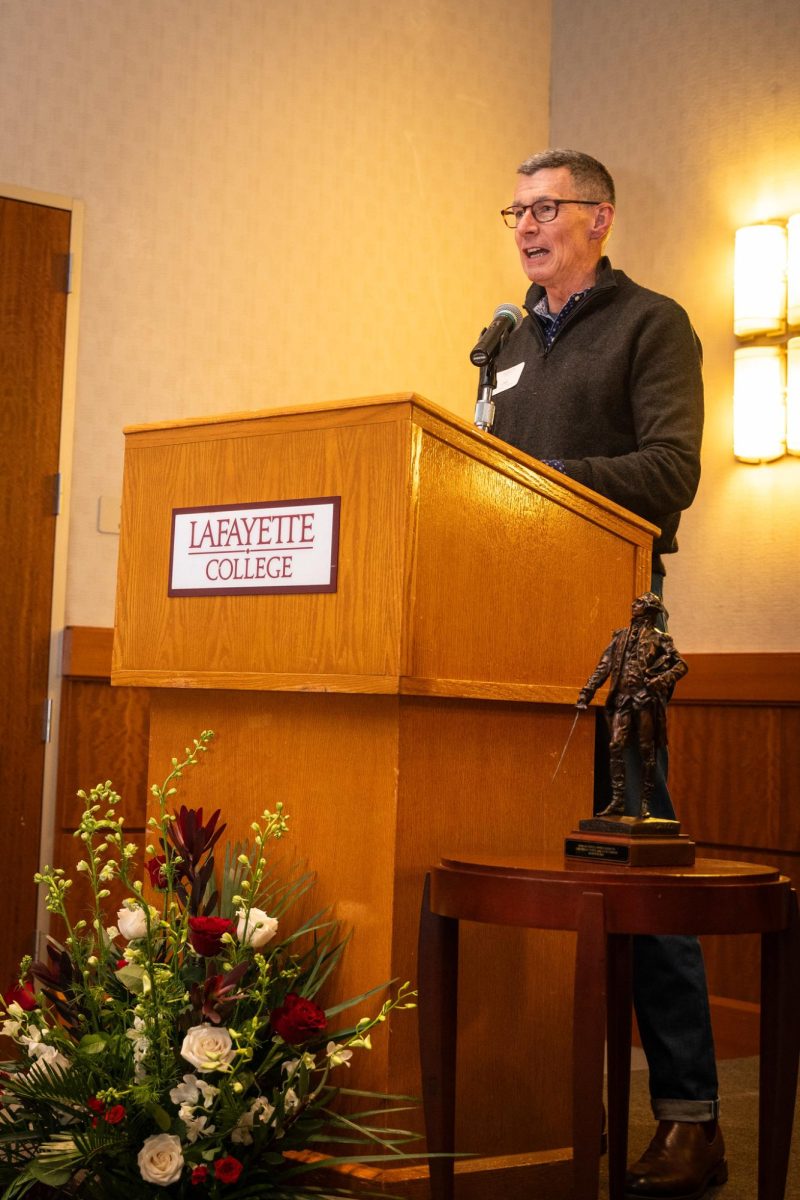Photo by Samantha Praman-Linton ‘16

Gershon Baskin, a renowned expert on Israeli-Palestinian relations, spoke at Lafayette this Monday in a lecture titled “The Failed Oslo Peace Process: What Went Wrong and Lessons Learned.”
Baskin, a founder of Israel/Palestine Center for Research and Information, a public policy think tank based in Jerusalem that assisted with the Oslo Peace Accords negotiations in the early 1990s, focused his talk the events leading up to the Israeli-Palestinian crisis the current possibility of a peace agreement between the two states.
Baskin started the lecture on a positive note by mentioning that recently, Israeli Prime Minister Benjamin Netanyahu announced that he was prepared to address the Palestinian people and invited Palestinian President Mahmoud Abbas to address the Israeli people.
He aimed to explain what the peace process was based on and how it went wrong.
He discussed the motivations of both the Israeli and Palestinian movements and described them both as national movements. Each group believes that the land, which is “sometimes called Israel, sometimes called Palestine,” belongs to them entirely and this land is an expression of their identity. It is a hundred year conflict over this land that people on both sides “have been willing to do for.” Both Palestinians and Israelis alike believe that they have a “natural, religious and historic right” to this land.
Baskin detailed attempts prior to the Oslo talks that hoped to resolve the conflict. In 1947, UN Resolution 181 was proposed which was a partition plan that aimed to divide the land between the Palestinians and the Jewish people. The Jews accepted the terms of the plan while the Arabs did not. The tension between the two groups continued on with Arabs refusing to recognize the Israel as a state.
In 1967, the Six Day War occurred. Arab-controlled land had been overtaken by Israel. For nearly twenty years, Israel occupied these lands “with no cost,” but this changed in 1987 with the First Palestinian Intifada. With this uprising, the language from Palestinian leaders changed from a message that called for the eradication of a Jewish state to rhetoric of a two-state solution.
Baskin realized then that a “political earthquake was taking place in the Middle East.” In 1988, he visited a Palestinian refugee camp and went to “understand what it is [they were] fighting for.” In that same year, the Palestinian Declaration of Independence was written and mentions the creation of a Jewish and an Arab state on the disputed land, which is known as a two state solution. This was “the basis on which the peace process was born.”
In 1993, the Palestinians and Israelis exchanged letters of recognition. Baskin believed that both groups were always engaged in mutual non-recognition and this was a primary reason as to why peace negotiations were never able to take place in the past. Although the letters were exchanged, Baskin says that “mutual recognition was not parallel” because the PLO recognized the Israeli state, whereas Israel only recognized the PLO as a representation of the Palestinian people rather than Palestine’s right to a state. This was the first failure of the peace process.
Baskin made it clear that the Oslo negotiations “were not peace treaties,” but instead “established a peace process” that established trust that would eventually lead to an actual peace agreement that would deal with the “hard issues” such as the creation of the Palestinian state and the future of Jerusalem. The Oslo agreements created 26 joint bodies that were aimed at building this trust between the groups.
Towards the end of the lecture, Baskin listed what went wrong during the process and why the goals of the negotiations were never brought to fruition. Baskin lists the assassination of Israeli Prime Minister Yitzhak Rabin by an Israeli opposed to the negotiations was the “single most critical moment in the peace process that was make or break.” Baskin also lists the continuation of violence and the emergence of fundamentalist groups as other issues that hindered the peace process.
He believes that the process was started “without an end game.” This was a lesson learned from the failure of the peace process. In order to reach peace, he said, there needs to be a reverse approach that begins with a defined destination.








































































































